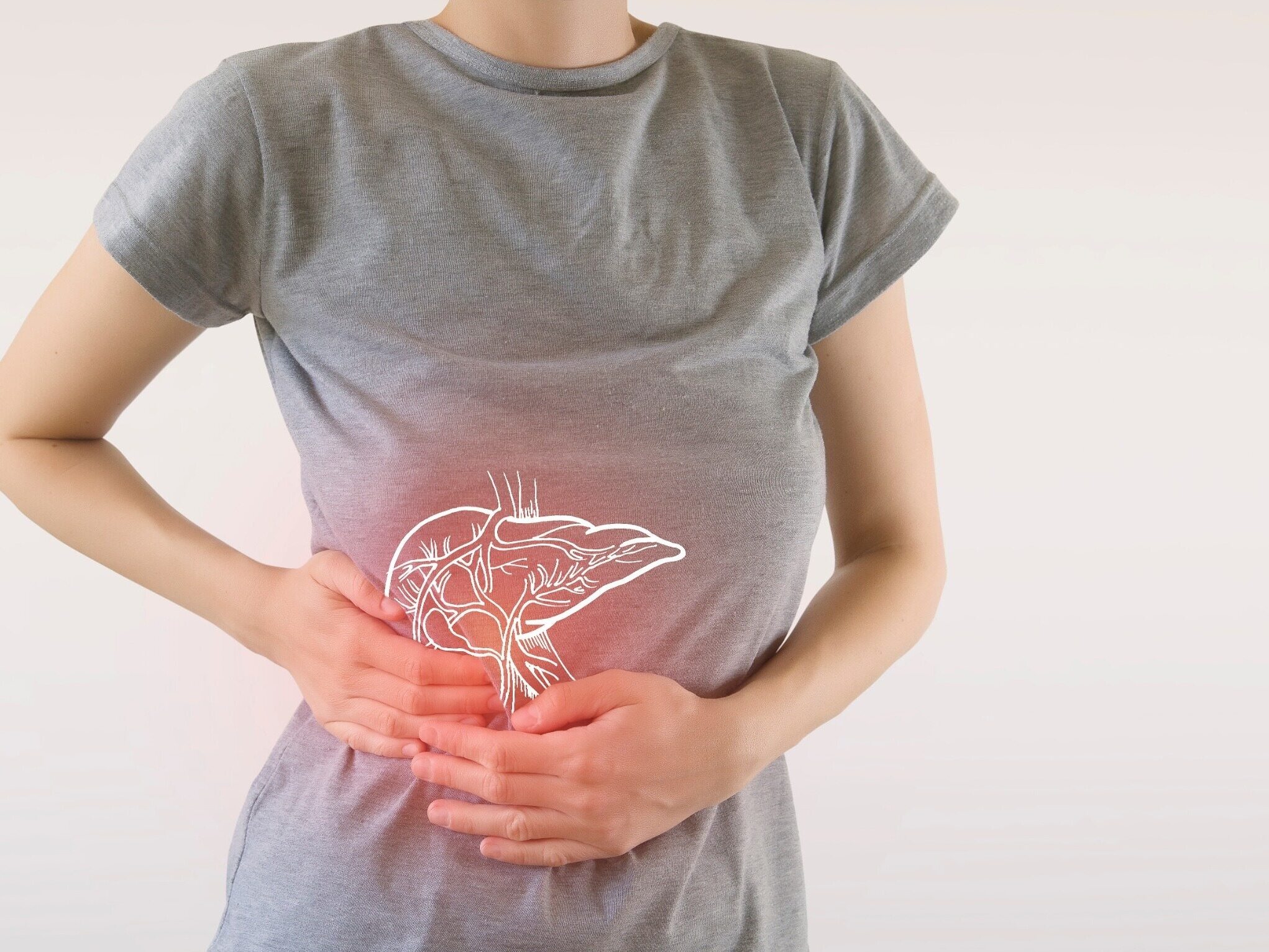Fatty liver – causes, symptoms, treatment and prevention

Fatty liver disease is a disease that is associated with the accumulation of fat in liver cells. It is most often associated with alcohol abuse – alcoholic fatty liver disease is one of the serious consequences of alcoholism. However, fatty liver disease is caused not only by excessive consumption of alcoholic beverages. What are the common causes and symptoms of fatty liver disease? How to treat them? We explain.
- Fatty liver disease – basic information
- What is fatty liver disease?
- Alcoholic fatty liver disease and non-alcoholic fatty liver disease (NAFLD)
- Symptoms of fatty liver disease
- How to prevent fatty liver disease?
- Treatment of fatty liver disease
Liver diseases are a large group of diseases that have various causes, but in most cases, they develop asymptomatically. The liver does not have sensory innervation, which means that pathological changes within it do not cause pain. Pain in the right hypochondrium (pain in the upper right abdomen), which may indicate liver disease, occurs when the liver becomes enlarged and begins to press on surrounding organs. Painful enlargement of the liver indicates an advanced disease process. Frequently diagnosed liver diseases include alcoholic liver disease (alcoholic fatty liver disease, alcoholic hepatitis, alcoholic cirrhosis) and non-alcoholic fatty liver disease (non-alcoholic fatty liver disease, non-alcoholic steatohepatitis).
Fatty liver disease – basic information
Lifestyle has a significant impact on the development of liver diseases. The liver is a parenchymal organ that performs many important functions in the body. The risk of developing liver disease in people leading a healthy lifestyle is low. Liver health is influenced by, among others:
-
diet used,
-
stimulants (especially alcohol),
-
medications taken,
-
metabolic diseases,
-
autoimmune diseases.
The group at risk of developing liver diseases, in addition to people abusing alcohol and people chronically using over-the-counter and prescription drugs, includes people who are overweight and obese, people with diabetes and insulin resistance, celiac disease, and inflammatory bowel diseases (e.g. ulcerative colitis). ), as well as people who have been poisoned by various toxins (e.g. ate poisonous mushrooms such as Amanita mushroom).
The risk of developing fatty liver disease occurs in the course of many diseases, but appropriate treatment and elimination of harmful habits can effectively reduce it. Early diagnosis of liver diseases is possible thanks to systematic screening tests, which include, among others: liver tests and abdominal ultrasound examination.
What is fatty liver disease?
Fatty liver disease involves the deposition of fat in liver cells and is related to metabolic disorders. The direct causes of the accumulation of fats in the liver are disorders of fatty acid metabolism in adipocytes, muscles and liver, as well as insulin resistance and oxidative stress. Disorders of fatty acid metabolism, which lead to fatty liver disease, are a pathological condition with a risk of serious complications. As a result of progressive fatty liver disease, liver fibrosis and cirrhosis may occur.
Failure to treat metabolic disorders that cause fat droplets to accumulate in liver cells triggers the inflammatory process. Chronic inflammation of the liver is one of the complications of fatty liver disease. Lack of appropriate treatment may lead to liver damage and failure of this organ.
Liver cirrhosis develops as a result of generalized damage to the liver parenchyma. Significant liver fibrosis is a symptom of advanced stages of liver disease. It is worth knowing that detecting fatty liver disease and other liver diseases at an early stage and implementing appropriate treatment helps avoid irreversible liver damage, which may lead to premature death due to liver cirrhosis.
The liver is an organ without which basic life processes cannot take place. In some cases, the only way to avoid premature death from liver damage is a liver transplant.
Alcoholic fatty liver disease and non-alcoholic fatty liver disease (NAFLD)
Alcoholic fatty liver disease and non-alcoholic fatty liver disease are diseases that have different causes – excessive accumulation of triglycerides in the blood, which the organ cannot cope with.
Alcoholic fatty liver disease – causes
Alcoholic fatty liver disease is caused by excessive alcohol consumption. This disease develops, among others, in people with alcoholism disease, but it is not only addictive alcohol drinking that has a destructive impact on the liver. Controlled excessive alcohol consumption, which is not related to alcohol addiction, can also lead to alcoholic fatty liver disease. It is worth knowing that there is no safe dose of alcohol that would avoid complications related to drinking it. The impact of alcohol on the body is determined by, among others: individual tendencies, as well as general health.
Ingested alcohol is metabolized mainly in the liver. It is a myth that drinking small amounts of alcohol does not negatively affect the functioning of the liver. Alcoholic fatty liver disease causes both long-term excessive alcohol consumption in large amounts and alcohol abuse that does not lead to significant alcohol intoxication.
People who abuse alcohol for a long time are at greater risk of developing alcoholic fatty liver disease. The statistics regarding alcoholic fatty liver disease, alcoholic hepatitis and alcohol-related cirrhosis are alarming. The incidence of alcoholic fatty liver disease and mortality caused by liver diseases are systematically increasing, including: in women. It is worth knowing that women are more sensitive to the effects of alcohol – in the case of women, lower doses of alcohol are toxic to the liver and steatosis and liver damage occur more quickly.
Doctors warn that alcoholic fatty liver disease is more and more often detected in young people aged 25-34. Just a few decades ago, this disease was diagnosed primarily in middle-aged and elderly people abusing alcohol. Fatty liver disease is the first stage of alcohol-related liver damage. The next stages are alcoholic hepatitis and alcoholic cirrhosis.
Non-alcoholic fatty liver disease (NAFLD)
Non-alcoholic fatty liver disease (NAFLD) is associated with the impact of other toxic factors on the liver, including: substances present in medicines. It may also be related to the course of some diseases. The causes of non-alcoholic fatty liver disease include:
-
medications used chronically or in too high doses (e.g. some antibiotics, cytostatics, salicylates, glucocorticosteroids);
-
metabolic disorders (non-alcoholic fatty liver disease may occur in people with diabetes, hyperlipidemia and hyperadrenocorticism);
-
long-term parenteral nutrition;
-
dietary mistakes made (e.g. overweight, obesity, starvation, which causes a deficiency of nutrients);
-
some infectious diseases (e.g. typhoid fever, hepatitis C – hepatitis C, fulminant hepatitis D);
-
some metabolic diseases (e.g. Gaucher’s disease, Wilson’s disease, Wolman’s disease).
Very often, non-alcoholic fatty liver disease is caused by a high-calorie diet rich in processed products (e.g. fast food), as well as a diet rich in saturated fats and refined sugars. The destructive impact of dietary mistakes on the liver is increased by lack of physical activity.
The causes of fatty liver disease are mostly modifiable factors, which means that their elimination enables effective liver regeneration, preventing damage to the cells of this organ. Fatty liver disease is a disease that can be avoided by taking care of your liver health.
Although in many cases the causes of non-alcoholic fatty liver disease do not cause diagnostic difficulties (e.g. overweight, obesity, lipid disorders, alcohol abuse), it sometimes happens that it is difficult to clearly determine what led to the development of the disease.
Symptoms of fatty liver disease
The symptoms of fatty liver disease are not specific. The disease initially develops asymptomatically. As the disease progresses, both alcoholic fatty liver disease and non-alcoholic fatty liver disease can cause non-specific symptoms that are often ignored.
Fatty liver disease may be indicated by, among others:
-
recurrent gastric symptoms, e.g. flatulence, feeling of fullness in the abdominal cavity, pain or pressure in the right hypochondrium;
-
chronic fatigue and weakness;
-
sleep disorders.
Changes in the liver are visible in blood test results. Fatty liver disease may be indicated by, among others: abnormal liver enzyme test results, lipid disorders and abnormal blood sugar levels. Symptoms of fatty liver disease also include liver enlargement.
Fatty liver disease is often detected accidentally, e.g. during an abdominal ultrasound examination, which is performed to diagnose other diseases or for preventive purposes.
Typical symptoms of fatty liver disease and other liver diseases appear when this organ becomes significantly enlarged and liver function is impaired.
How to prevent fatty liver disease?
Fatty liver disease can be prevented. Reducing the risk factors for the development of the disease allows not only to prevent its occurrence, but also enables effective regeneration of the liver and reversal of pathological changes in this organ.
Non-alcoholic fatty liver disease can be prevented by changing your diet, losing weight and regular physical activity. To prevent alcoholic fatty liver disease, you must stop drinking alcohol.
It is worth remembering that long-term use of certain medications also leads to fatty liver disease. People who chronically use over-the-counter and prescription drugs should have their liver checked regularly.
Treatment of fatty liver disease
Treatment for fatty liver disease depends on the cause of fat accumulation in liver cells. First of all, it is necessary to eliminate the factor that led to the development of the disease. Depending on the degree of fatty liver disease, the reduction of harmful factors may lead to the reversal of the disease or slow down the course of the disease.
Sources:
-
M. Piechota, Liver dysfunction causes, diagnosis, qualification and intensive treatment, Makmed, 2016
-
A. Habior, Non-alcoholic fatty liver disease and obesity, Borgis – Postępy Nauk Medycznych 5b/2013, pp. 31-37dr n. med. J. Gietka, MD. J, Klapaczyński, Fatty liver disease – diagnosis and treatment, Post-Diploma Medicine 2016/10






